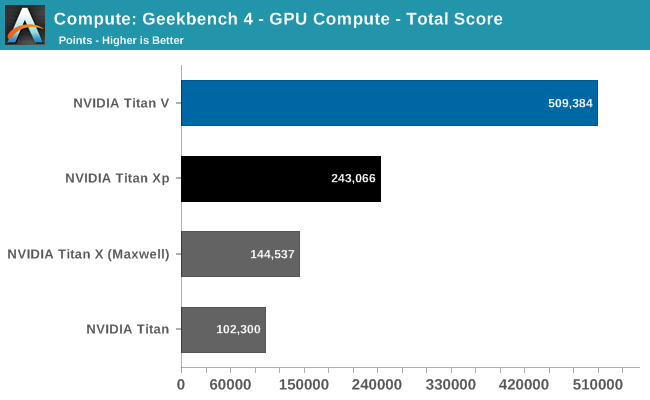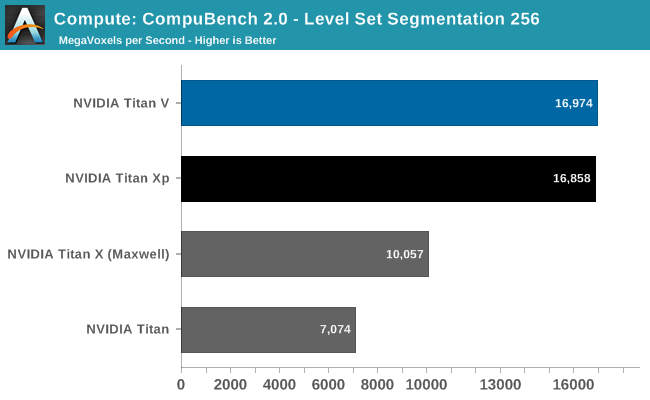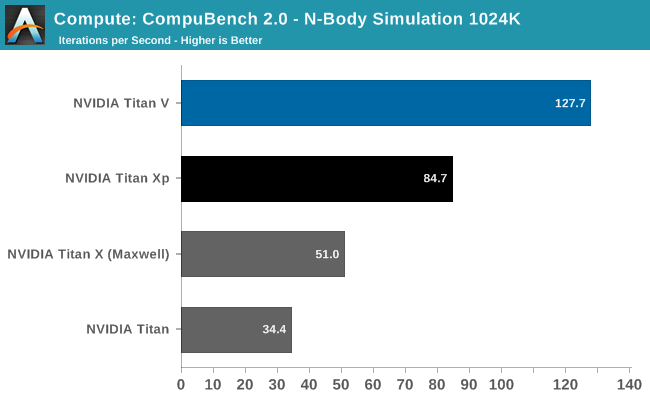The NVIDIA Titan V Preview - Titanomachy: War of the Titans
by Ryan Smith & Nate Oh on December 20, 2017 11:30 AM ESTCompute Performance: Geekbench 4
In the most recent version of its cross-platform Geekbench benchmark suite, Primate Labs added CUDA and OpenCL GPU benchmarks. This isn’t normally a test we turn to for GPUs, but for the Titan V launch it offers us another perspective on performance.

The results here are interesting. We’re not the only site to run Geekbench 4, and I’ve seen other sites with much different scores. But as we haven’t used this benchmark in great depth before, I’m hesitant to read too much into it. What it does show us, at any rate, is that the Titan V is well ahead of the Titan Xp here, more than doubling the latter’s score.
| NVIDIA Titan Cards GeekBench 4 Subscores | ||||||
| Titan V | Titan Xp | GTX Titan X | GTX Titan | |||
| Sobel (GigaPixels per second) |
35.1 | 24.9 | 16.5 | 9.4 | ||
| Histogram Equalization (GigaPixels per second) |
21.2 | 9.43 | 5.58 | 4.27 | ||
| SFFT (GFLOPS) |
180 | 136.5 | 83 | 60.3 | ||
| Gaussian Blur (GigaPixels per second) |
23.9 | 2.67 | 1.57 | 1.45 | ||
| Face Detection (Msubwindows per second) |
21.7 | 12.4 | 8.66 | 4.92 | ||
| RAW (GigaPixels per second) |
18.2 | 10.8 | 5.63 | 4.12 | ||
| Depth of Field (GigaPixels per second) |
3.31 | 2.74 | 1.35 | 0.72 | ||
| Particle Physics (FPS) |
83885 | 30344 | 18725 | 18178 | ||
Looking at the subscores, the Titan V handily outperforms the Titan Xp on all of the subtests. However it’s one test in particular that stands out here, and is likely responsible for the huge jump in the overall score, and that’s the Gaussian Blur, where the Titan V is 9x (!) faster than the Titan Xp. I am honestly not convinced that this isn’t a driver or benchmark bug of some sort, but it may very well be that Primate Labs has hit on a specific workload or scenario that sees some rather extreme benefits from the Volta architecture.
Folding @ Home
Up next we have the official Folding @ Home benchmark. Folding @ Home is the popular Stanford-backed research and distributed computing initiative that has work distributed to millions of volunteer computers over the internet, each of which is responsible for a tiny slice of a protein folding simulation. FAHBench can test both single precision and double precision floating point performance, giving us a good opportunity to let Titan V flex its FP64 muscles.

A CUDA-backed benchmark, this is the first sign that Titan V’s performance lead over the Titan Xp won’t be consistent. And more specifically that existing software and possibly even NVIDIA’s drivers aren’t well-tuned to take advantage of the Volta architecture just yet.
In this case the Titan V actually loses to the Titan Xp ever so slightly. The scores are close enough that this is within the usual 3% margin of error, which is to say that it’s a wash overall. But it goes to show that Titan V isn’t going to be an immediate win everywhere for existing software.
CompuBench
Our final set of compute benchmarks is another member of our standard compute benchmark suite: CompuBench 2.0, the latest iteration of Kishonti's GPU compute benchmark suite. CompuBench offers a wide array of different practical compute workloads, and we’ve decided to focus on level set segmentation, optical flow modeling, and N-Body physics simulations.



It’s interesting how the results here are all over the place. The Titan V shows a massive performance improvement in both N-Body simulations and Optical Flow, once again leading to the Titan V punching well above its weight. But then the Level Set Segmentation benchmark is practically tied with the Titan Xp. Suffice it to say that this puts the Titan V in a great light, and conversely makes one wonder how the Titan Xp was (apparently) so inefficient. The flip side is that it’s going to be a while until we fully understand why certain workloads seem to benefit more from Volta than other workloads.










111 Comments
View All Comments
tipoo - Wednesday, December 20, 2017 - link
This would be a pretty bad choice for mining.The tensor cores don't work on any current mining algorithm. The CUDA cores have a small uplift. Two 1080s would be much faster miners.
lazarpandar - Wednesday, December 20, 2017 - link
Really disappointed that there isn’t a tensorflow performance tab since there is literally a physical portion of the gpu dedicated to tensor cores.Ryan Smith - Wednesday, December 20, 2017 - link
The good news is that we're working on that for the full review. The deep learning frameworks are a lot harder to test, and we were running out of time ahead of the holiday break, so it had to get pulled. It's definitely looking interesting though.SharpEars - Wednesday, December 20, 2017 - link
I applaud the increase in double-precision, but 12 GB of VRAM, seriously? For a $3k card?DanNeely - Wednesday, December 20, 2017 - link
Blame problems with either the memory controller and/or the interposer connecting the HBM2. NVidia kept the core count the same vs Tesla, but dropped one of the 4 ram stacks; so we know that something related to that was the biggest failure point in turning dies into even more expensive Tesla cards.Titan V refresh might get the 4th stack for 16GB in a year or so if yields improve enough to justify it; otherwise the question for more ram becomes if/when 8GB stacks of HBM2 are available in sufficient quantity.
extide - Saturday, December 23, 2017 - link
Vega FE and 16GB Mac Pro versions use the 8GB stacks, so they are available to some degree..mode_13h - Wednesday, December 27, 2017 - link
Nvidia's market segmentation tactics won't allow for 16 GB of HBM2 at such a bargain price. You might get it in the form of a Quadro GV100, however, for >= $2x of Titan V.beisat - Wednesday, December 20, 2017 - link
I fully expect the rumours to be true and Volta to be skipped for gaming by NV - already we heard of a replacement (Ampere) and this points that way too. Just a feeling though...Qwertilot - Wednesday, December 20, 2017 - link
Well, there’s no way they’d ever include a lot of the compute features in gaming cards so the two were always going to be pretty different.What they end up calling everything is a bit of a moot point :)
crysis3? - Wednesday, December 20, 2017 - link
so why'd you run the benchmark on the original crysis no one benchmarks? I assume the titan v cannot get 60fps maxed out on crysis 3 then.